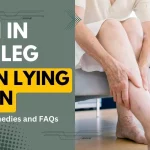Experiencing sudden pain in leg without injury can be perplexing and concerning. Understanding the causes, treatment options and prevention strategies for this type of pain is crucial for managing it effectively.
Understanding Sudden Leg Pain
Sudden leg pain without injury refers to the onset of acute pain in the leg without any traumatic event or physical damage. It is important to differentiate this type of acute pain from chronic pain, characterized by persistent discomfort over a prolonged period.
Potential Causes of Sudden Leg Pain without Injury
Various potential causes of sudden leg pain without injury can be categorized into different groups.
Muscle-related causes
- Muscle cramps: Sudden and involuntary muscle contractions can cause severe pain in the leg.
- Muscle strain: Overexertion or excessive physical activity can lead to muscle strain, resulting in sudden leg pain.
- Muscle imbalances: Muscle strength or flexibility imbalances can cause pain in different leg areas.
Joint-related causes
- Joint inflammation: Conditions like rheumatoid arthritis or lupus can lead to joint inflammation, causing sudden leg pain.
- Osteoarthritis: Degeneration of the joints due to wear and tear can cause sudden pain in the leg.
- Gout: A form of arthritis caused by the buildup of uric acid crystals in the joints can result in sudden and intense leg pain.
Nerve-related causes
- Peripheral neuropathy: Damage to the peripheral nerves can lead to sudden leg pain, numbness or tingling sensations.
- Sciatica: Compression or irritation of the sciatic nerve can cause shooting pain down the leg.
- Restless legs syndrome: A neurological disorder characterized by an uncontrollable urge to move the legs, which can be accompanied by pain or discomfort.
Vascular causes
- Deep vein thrombosis (DVT): A blood clot that forms in a deep vein, typically in the leg, can cause sudden pain, swelling and redness.
- Peripheral artery disease (PAD): Narrowing of the arteries that supply blood to the legs can result in sudden leg pain, especially during physical activity.
- Varicose veins: Enlarged and twisted veins can lead to sudden leg pain and visible bulging veins.
Medical conditions and other causes
- Chronic venous insufficiency: Inadequate blood flow from the leg veins to the heart can cause sudden leg pain and swelling.
- Thrombophlebitis: Inflammation of the veins due to blood clots can result in sudden leg pain.
- Compartment syndrome: Increased pressure within the muscles can cause sudden and severe leg pain, often accompanied by swelling and tightness.
Psychological factors
- Stress-induced leg pain: High-stress levels can lead to muscle tension and localized pain in the leg.
- Psychosomatic leg pain: Emotional or psychological factors can manifest as physical leg pain without injury.
- Anxiety-related leg pain: Anxiety disorders can contribute to the onset of sudden leg pain.
Diagnostic Process for Sudden Leg Pain without Injury
When experiencing sudden leg pain without any injury, it is important to undergo a thorough diagnostic process to identify the underlying cause. This usually involves the following steps:
Medical history assessment
The healthcare provider will inquire about the individual’s medical history, including any previous leg pain episodes or underlying conditions that may contribute to the pain.
Physical examination
A comprehensive physical examination will evaluate the affected leg, looking for visible signs of injury or abnormalities.
Laboratory tests
Blood tests may be performed to check for markers of inflammation, infection or other underlying causes of leg pain.
Imaging studies
X-rays, ultrasounds or MRI scans may be ordered to visualize the structures within the leg and detect any abnormalities.
Electromyography (EMG) and nerve conduction studies (NCS)
These tests evaluate the electrical activity and functioning of the muscles and nerves in the leg, helping pinpoint the pain’s cause.
Treatment Options for Sudden Leg Pain without Injury

The treatment approach for sudden leg pain without injury depends on the underlying cause and severity. Some common treatment options include:
Self-care and lifestyle modifications
- Resting and elevating the leg to alleviate pain and reduce swelling.
- Applying heat or cold therapy to the affected area for pain relief.
- Engaging in specific stretching exercises to improve muscle flexibility and reduce imbalances.
Medications
- Over-the-counter pain relievers such as ibuprofen or acetaminophen may be recommended for mild to moderate pain.
- Muscle relaxants may be prescribed to relieve muscle spasms and tension.
- Topical creams or ointments containing analgesic or anti-inflammatory ingredients may help alleviate localized pain.
Physical therapy and rehabilitation programs
Working with a physical therapist can help address muscle imbalances, improve mobility and provide targeted exercises for pain management.
Interventional procedures
In some cases, interventional procedures like corticosteroid injections or nerve blocks may be considered to alleviate pain and promote healing.
Alternative therapies
Complementary approaches such as acupuncture, chiropractic care or herbal remedies may relieve some individuals.
Surgical interventions (if necessary)
In rare cases where conservative treatments fail to provide relief, surgical interventions may be recommended to address the underlying cause of the leg pain.
Prevention Strategies for Sudden Leg Pain without Injury
While sudden leg pain without injury may not always be preventable, adopting certain lifestyle habits may reduce the risk and severity of these episodes:
Maintaining a healthy lifestyle
- Following a balanced diet rich in essential nutrients can promote overall musculoskeletal health.
- Avoiding smoking and excessive alcohol consumption can improve circulation and reduce inflammation.
Regular exercise routine
- Regular physical activity, such as walking, swimming or cycling, helps strengthen the muscles, joints and cardiovascular system.
Wearing appropriate footwear
- Choosing comfortable and supportive shoes that fit properly can minimize the risk of developing leg pain or injuries.
Adequate hydration
- Staying well-hydrated can help prevent muscle cramps and promote optimal circulation.
Proper warm-up and cooldown routines
- Before physical activity, warming up the muscles and gradually increasing their flexibility and blood flow is important. Cooling down after exercise helps prevent muscle soreness.
Good night’s sleep is important for your overall well-being, so you can use best mattress to relieve leg pain.
In Summary, Experiencing sudden leg pain without any injury can be bewildering, but understanding the potential causes, treatment options, and prevention strategies can assist in managing this type of pain effectively. It is essential to seek medical advice for an accurate diagnosis and appropriate treatment.
FAQs
Can sudden leg pain occur without any injury?
Yes, sudden leg pain can occur without any apparent injury. Many factors, including muscle strain, nerve issues, vascular conditions, and medical or psychological factors, can cause it.
How long should I wait before seeking medical attention for sudden leg pain?
If you experience sudden and severe leg pain without apparent injury, seeking medical attention promptly is generally advisable. It is better to have a professional evaluation to identify and address the underlying cause.
Are there any home remedies for relieving sudden leg pain without injury?
While home remedies such as rest, elevation, applying heat or cold therapy and stretching exercises may temporarily relieve mild cases of sudden leg pain, it is important to consult a healthcare provider for a proper diagnosis and appropriate treatment.
Can stress or anxiety cause sudden leg pain?
Yes, stress and anxiety can contribute to muscle tension, which may result in sudden leg pain. Psychological factors can manifest as physical symptoms, including leg pain, even without injury.
Is sudden leg pain a sign of a serious health condition?
Sudden leg pain can be a mild and serious symptom of various health conditions. Consulting a healthcare professional to determine the underlying cause and receive appropriate treatment is important.



